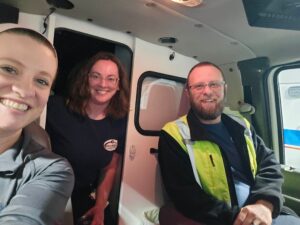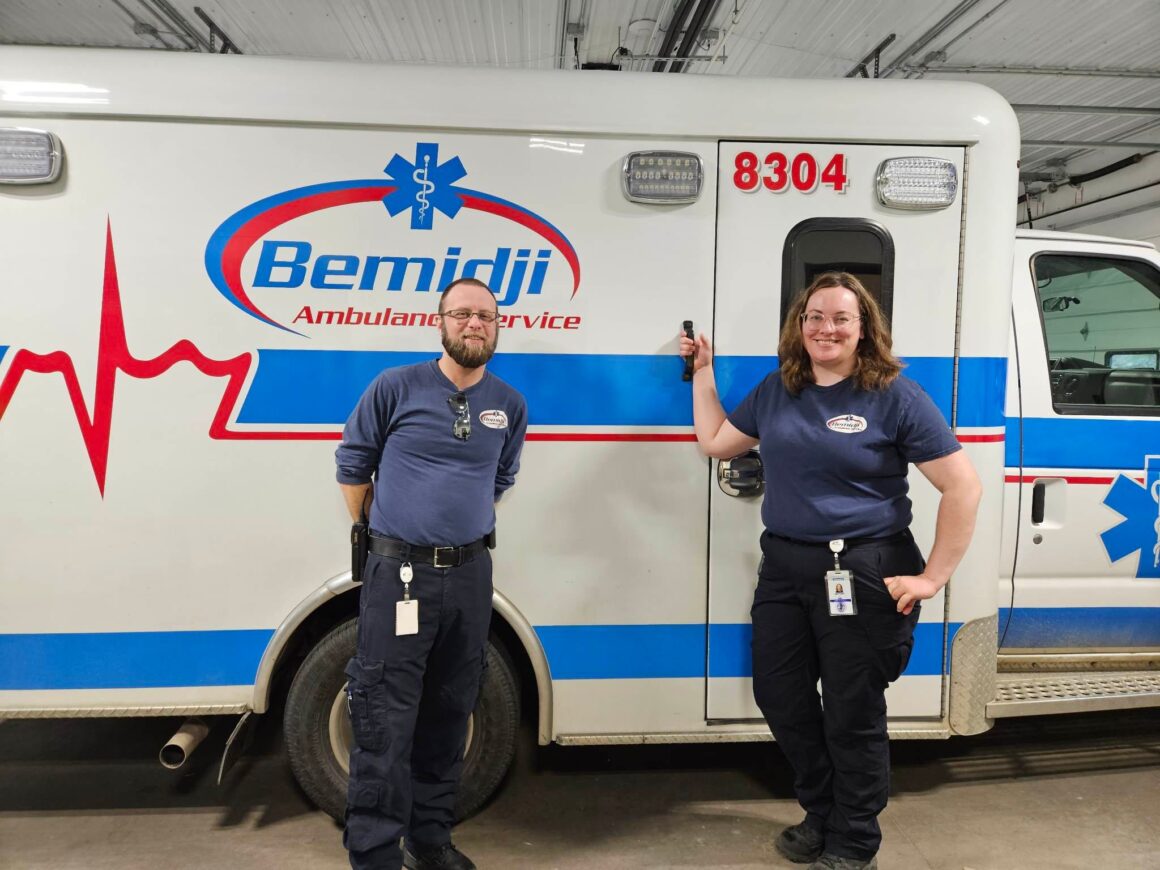It’s back!
After I took April off from the “People Who Go to Work Earlier Than I Do” series, I had the great privilege of spending the morning with the crew at Bemidji Ambulance Service.

My guides for the “shift” were EMT Britany and Paramedic Brandon.
Most of our time was spent in the “lodge” part of the garage. Did you know ambulance workers work 48-hour shifts with two days on, and four days off? Brandon and Britany said that a 12-hour shift model is coming soon, too.
One of my first questions was about sirens. After spending two weeks in the major cities of France and hearing those ones, I wondered why they sound so different across the continents.
Brandon explained that sirens are designed to catch attention, and the differences really boil down to what people are used to. There are three types of sirens: the wail, a long siren sound used in more remote areas; the yelp, often heard at intersections; and the chirp, the shortest siren sound.
Britany moved to emergency medical service from marketing after experiencing COVID-19 pandemic burn-out and said a motorcycle accident she was in helped inspire her into this line of work. Brandon grew up in a family of first responders so becoming a paramedic was second nature!
The most frequent type of calls ambulance workers like Britany and Brandon respond to are mental health-related calls and geriatric-related incidents.
Car crashes, Britany and Brandon said, have become less severe in recent years, largely thanks to the additional safety features car manufacturers are installing. Brandon went into the physics of what happens in a car crash, and it’s a good thing I didn’t eat breakfast yet. Apparently, when your car comes to a sudden stop, your organs take a little bit longer.
As someone who is vertically challenged, car crashes are a top-of-mind concern as I need to sit very close to the steering wheel to reach the pedals. Brandon said that when the airbag goes off, it will hurt but I should live so I’ve got that going for me!
We also talked about communications with dispatch. Prior to 9/11, dispatchers would use what is called “10 codes” (i.e., 10-4, which means all-clear), but when multiple agencies responded to the tragedy that unfolded in New York City that day, there was a lot of miscommunication because 10 codes can vary from jurisdiction to jurisdiction. Now, dispatchers generally use plain language, while 10 codes are still preferred for law enforcement officers.

Britany and the Pager
As someone who listens in on the scanner from time to time, I often have a hard time understanding what’s being said (of course, I never base my news stories on scanner chatter alone), but behold! The technology Britany displays. This is what’s called a “pager!”
The pager helps document the calls and lets the emergency workers have an idea of what to expect when they arrive.

Pager!
Documentation is key for every call an ambulance team takes on.
We can all imagine the types of injuries and incidents ambulance workers respond to on a day-to-day basis. I asked how they manage when they get to particularly gruesome scenes.
Brandon says the human body is amazingly resilient, but emergency workers have to keep their feelings in check to do their job effectively.
Britany said the calls involving children can get especially tough but it’s important to be able to decompress, like in the kitchen area of the lodge, talking with fellow coworkers, or having some alone time in a private bunk.
Thanks Britany and Brandon and the rest of the Bemidji Ambulance Services team for giving me this insight into your noble profession, as well as all the work done every day around the clock.
Do you have an early job? If you’re interested in a job shadow with me, reach out to me via email!
Check out my MnDOT Snowplow and Beltrami County Sheriff’s Office ride-alongs, too!




